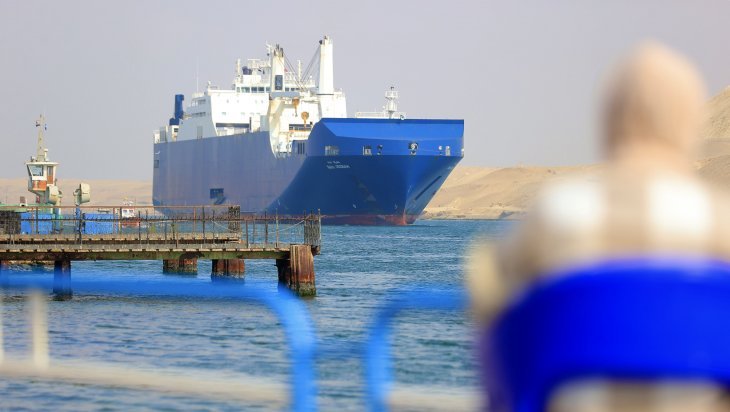Threats to Red Sea Security and Regional Implications

Following the events of October 7, the Houthi missile and drone attacks on Israeli-flagged ships passing through Bab el-Mandeb have brought the issue of Red Sea security back to the forefront of the international community's agenda. These attacks have adversely affected international trade and security. The impacts on this critical route, which constitutes at least 12% of global maritime trade, were immediate.
The global shipping industry has rerouted trade routes between Asia and Europe away from the Red Sea, altering the logistics flows between these major markets. Increased shipping insurance costs have led to higher prices for goods reaching both countries bordering the Red Sea and consumers worldwide. Ships forced to detour around South Africa add approximately two weeks and 6,000 nautical miles to their journeys. Such changes create uncertainty for countries dependent on imports, resulting in a highly unpredictable commercial environment. For example, Egypt's annual revenue of $10 billion from ships passing through the Suez Canal is directly affected by this uncertainty.
These rising freight costs result in significant price increases for imported and exported goods for consumers and businesses. In particular, landlocked countries in East Africa, dependent on the free flow of goods through the Red Sea, experience direct and profound impacts on their livelihoods and living conditions.
Increasing Conflicts and Security in the Red Sea
Additionally, the marine pollution caused by regional conflicts has devastating effects on the coastal and marine ecosystems of the Middle East and Africa along the Red Sea. In East Africa, 57 million people are facing acute food insecurity, including over 10 million refugees and internally displaced persons. In Sudan alone, 8 million displaced people rely heavily on food aid transported through the Red Sea.
Furthermore, Houthi attacks also threaten the fibre optic cables connecting Europe and Asia. For instance, it is claimed that three out of twenty undersea cables were damaged following the sinking of the Rubymar ship by a Houthi missile.
In conclusion, the increase in the cost of consumer goods, the weakening of economic structures, and the rising marine pollution caused by disrupted waterways directly affect the quality of life of people living in the Middle East and Africa. Therefore, the regional security issues interacting with the instability in Yemen and Israel's attacks on Gaza highlight the fragility of the Red Sea.
Threat Elements
Five fundamental threats to Red Sea security in the 21st century can be highlighted: Houthi attacks on commercial ships, piracy and maritime robbery, armed conflicts and political instability, illegal fishing and environmental threats, and global competition.
Firstly, since October 7, 2023, in retaliation for Israel's attacks on Gaza, Houthi interventions with missiles and drones on Israeli-flagged commercial ships using the Red Sea route have negatively impacted the regional and global economies. This has resulted in increased global inflation, disruptions in aid to countries like Sudan experiencing humanitarian crises due to civil war, and negative effects on the Egyptian economy due to the decrease in the number of ships passing through the Red Sea. However, Israel has not ceased its operations in Gaza and has not agreed to a ceasefire.
Secondly, the issue of piracy and maritime robbery in the region is significant, particularly near the coasts of Somalia. Somali piracy and maritime robbery have been serious concerns drawing international attention since the early 2000s, especially affecting the Gulf of Aden and parts of the Indian Ocean. The prolonged civil war in Somalia and the collapse of state structures led to the control of the country's long coastline remaining unchecked. Particularly between 2008 and 2012, the Gulf of Aden was considered the most dangerous maritime region globally, with pirates hijacking commercial ships and demanding ransom. In response, naval forces from NATO, the European Union, and other countries began patrolling the area; shipping companies placed private security guards on their vessels; and the UN supported Somalia's stability efforts, leading to a reduction in such activities from 2012 onwards. However, the region still poses potential risks, and it should be noted that Türkiye's security framework agreement with the Somali state, announced in February 2024, aims to contribute to the stability of regional and global trade.
Thirdly, armed conflicts and political instability in Red Sea basin countries like Yemen, Somalia, Sudan, Ethiopia, and Eritrea affect regional security. The ongoing conflict in Yemen poses a serious risk, particularly to maritime security, as exemplified by the Houthi attacks mentioned in the first point. Additionally, the pirate activities highlighted in the previous point are exacerbated by the instability in Somalia.
Fourthly, illegal fishing poses threats to regional ecosystems. The Red Sea and Gulf of Aden host rich but fragile marine ecosystems. Illegal, unreported, and unregulated fishing activities in these regions threaten marine biodiversity and have long-term adverse effects on regional ecosystems. Illegal and overfishing, particularly of endangered and protected species such as sharks, corals, and various fish species, lead to population declines, threatening local economies and biological diversity. Therefore, addressing illegal fishing in the Red Sea and Gulf of Aden is a critical ecological and economic issue, requiring effective combat strategies.
Finally, the control of strategic waterways like the Suez Canal leads to competition among regional and global powers. The Red Sea, due to its strategic location and natural resources, is a stage for intense competition among global actors. The United States and European countries, along with major powers like China and Russia, are reinforcing their military and economic presence in the region, seeking control over trade routes and natural resources. The regional power struggle between Saudi Arabia and Iran further intensifies this competition, while multilateral cooperation and diplomatic efforts play a crucial role in maritime security and anti-piracy efforts. These dynamics in the Red Sea have significant implications for regional stability and international maritime security, indicating that this competition will continue in the future.
In conclusion, the Red Sea, as a critical juncture of international trade and strategic military movements, faces multifaceted security threats. Houthi attacks, regional conflicts, piracy activities, illegal fishing, and global competition over strategic waterways are among the factors threatening both regional and global stability. The uncertainties arising from these elements have direct economic consequences and profound impacts on human lives. The humanitarian crises in countries like Yemen, Somalia, and Sudan highlight the critical nature of these security issues. The international community must develop a coordinated and effective intervention strategy to address these threats, ensuring security in the Red Sea region and maintaining the flow of global trade. Thus, ensuring sustainable regional stability and strengthening global economic structures can be targeted. In this context, multilateral cooperation and diplomatic efforts emerge as indispensable elements for ensuring peace and prosperity at both regional and global levels.
This article was published in Turkish on April 30, 2024, on the Fokus+ website under the title “Kızıldeniz Güvenliğini Tehdit Eden Unsurlar ve Bölgesel Yansımalar.”








